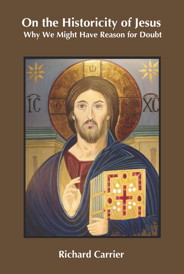After listening to the entertaining
Lowder-Vandergriff debate, I thought I’d reconsider my concept of Supernaturalism (”S”) in a more detailed manner. Jeffrey Jay Lowder argued that S and N are symmetric claims, but that Theism (”T”) and Christian Theism (”CT”) require extra explanations that make them inherently less probable than Naturalism (”N”). This matches my thinking - with a caveat - although the internal monologue that I have on the subject usually involves more prerequisites to move from S to T to CT because I have no internal time constraints.
My caveat is this: I agree with the idea that “just N” and “just S” in isolation from each other are symmetric claims, and thus equally plausible. However, claiming that S exists **in addition to** N as an explanation for the world we live in is more complicated, and per Ockham’s razor, would not be preferred to N only, given that N provides adequate explanations for phenomena that we observe in the world so far. Still, in order to proceed with this exploration, I will stipulate that S is required.
The outline for the exploration is roughly this:
- a Natural world “N” exists.
- how can a Supernatural world “S” exist?
- how can S be a Theistic (”T”) world?
- how can T be a Christian Theistic (“CT”) world?
Please notice that I assume that S is superordinate or prerequisite to T, which is superordinate or prerequisite to CT. This seems to be a conventional and uncontroversial position, and leaves open the possibility that S in fact exists but T and CT do not. It also becomes a candidate explanation for our human propensity for claiming T or CT exists, when “in reality” S is all there is. Just a thought!
A Natural world “N” exists
We will take the proposition that “A Natural world “N” exists” as axiomatic. Without it, we can’t claim that anything outside our heads exists, making further discussion irrelevant.
We also presume - approximately - that space-time, matter, energy and their properties, behaviors and relationships are what constitutes N, and that these are consistent (though not necessarily unchanging), thus they are observable, measurable, and we can evaluate them and make inferences about them.
How can a Supernatural world exist?
Here’s where I think I’ll spend most of my time. Since the point of the S..T..CT schema has as its end point an argument for the existence of the Christian God, I won’t deviate far from the S or T entities found in mainstream Christian thought.
The Supernatural realm “S” is assumed to exist
“above and beyond nature":
The supernatural (Medieval Latin: supernātūrālis: supra "above" + naturalis "nature", first used: 1520–30 AD)[1][2] is that which is not subject to the laws of physics or, more figuratively, that which is said to exist above and beyond nature
One could make the claim that S is wholly separate from N, a claim that is uncontroversial, although quite meaningless. For S to have meaning, something about it must have an affect on N that can be observed within N.
That opens up the first line of inquiry, “what is S’ relationship to N”? Among possible auxiliary questions are: what does S allow, what does S contain, how does S and/or objects contained in S exhibit behavior and potentially affect N? I might also ask whether N-objects can communicate or use S or S-objects in some way.
What is S’ relationship to N?
Since we presume that space-time, matter, energy and their properties, behaviors and relationships are what constitutes N-world, we might intuit that there is some set of similar concepts that constitute S-world. But before we try to reason out what minimal features are required to constitute S, we should ask “how is S situated in a cosmos that would allow S and N to interact”? Here are some unsophisticated postulates on how S and N might relate to each other:
- SR1. N-world and S-world are separate
- SR2. N and S are partially separate, but share some characteristics
- SR3. N and S are identical
- SR4. one supervenes upon the other
- SR5. one contains the other
- SR6. they coincide but remain separate
These are all ways you might reasonably conceive of S-world and its hypothetical relationship to N-world. There are undoubtedly more.
Let’s consider postulate SR1 (the “SR” standing for Supernatural Relationship). Before we can start imagining a relationship between S and N as posited in SR1, he have to presume that S has a way to remain spatially and temporally coordinated to N. There are at least three cheap ways to conceive of how S and N remain coordinated. One, they are “free-floating”, similar to two isolated
“bubble universes” 
. This scheme requires S to somehow update its “awareness” of N-world across the void. Two, they are coincident, but separate. The two realms are anchored to a common mooring. This assumes that the fundamental physics of S and N are such that they can occupy the same time and space - as we conceive it - and remain coordinated so that S-actions in N are coherent. Three, somewhat similar to One, is that S and N are free floating in a superordinate realm that allows coordination so that S-actions in N are coherent. This leaves open the question of how S-entities that act on N have spatial and temporal awareness of N-entities so that they can perform something recognizable as Supernatural in N-world. Let’s tag this question as Q1, in case we need to return to it later.
If S and N are separate, then a creator God could be found in this scheme, if either S or the hypothetical superordinate system is primary to N. This seems like a violation of Ockham’s Razor, in that we have two or three things requiring explanation. For the moment, let’s set aside the thought that S and N are separate as unnecessarily complex.
Postulate SR 2 - “S and N are partially separate, but share some characteristics” - is a tweener that arose during my initial brain dump. If S and N share characteristics, then we presume it is a level that we can’t yet perceive. So we can then presume that at unimaginably small or unimaginably large scales, we’ll find those shared characteristics. Either way we go, it leads to the conclusion that some fundamental aspects of reality are prerequisite to both N and S, but N and S deviate from these fundamentals as we traverse the ontology towards earth-like life.
For the moment, we will set aside SR2 as similar to SR 1 - unnecessarily complex - and move on to SR3.
SR3 - the speculation that S and N are identical - might just be a way to say “I don’t know what I’m talking about”. If S and N are “identical”, truly identical, then there is no characteristic that tells us which is which. Can we then say that there are different things that the terms “the Natural” and “the Supernatural” refer to? Could they refer to different ways of looking at the same thing? In that case, isn’t S just N via different interpretation? Or is S just N-objects and behavior that traditional science hasn’t discovered?
The problem with any of the candidate “explanations” given for SR3 in the prior paragraph is that they can and will be dismissed until repeatable observations of S-objects and behaviors are possible. So, as a hypothesis, it’s not dead, but it certainly isn’t compelling.
Postulate SR4 is one of
supervenience - the idea that lower level properties determine higher level properties. An example would be molecules supervene upon (or rely on) atoms for their existence. I’ll be honest, I’m throwing darts here. This could be interpreted as a clarification of SR2 through it’s bottom-up focus. It could be that S is fundamental, and N supervenes on it. This sounds suspiciously like the “God is the ground of all being” trope that you might have heard from some theologists, but once you get to known physical quantities, the “room” that you need for S-objects, particularly independent agents such as gods, seems to become occupied by N-objects. Let’s not rule this out.
Variation #2 of concept SR4 would be the reverse, that S supervenes on N. That is not obviously absurd, but it seems to preclude the eternal creator God that we hope to find in T and CT. Let’s label our two variations SR4a (N supervenes on S) and SR4b (S supervenes on N).
Postulate SR5 jumps out as me as plausible - that N contains S or S contains N. Lets mull this over. If N contains S, then N has primacy, and S will never get us to T-world, where we presume that an eternal creator God exists. However, if S contains N, then S is primary, and the possibility of eternal creator beings cannot be ruled out. In fact, a non-eternal but “sufficiently long lived” being that is powerful enough to create N would suffice to get to some semblance of T.
SR6 - the idea that S and N coincide but are separate, is just a clarification of SR1 in which the two are declared to be coincident, so let’s just roll this into SR1, and drop it as a separate conception.
This is becoming longer than I expected, so let me start next time with the remaining inquiries into the Supernatural, then proceed to T and CT.
 is suitably impressed and leaves with the news. Jesus then begins preaching again, using JB’s greatness (as a prophet) as a milestone against which He compares the greatness of those that belong to the Kingdom of God. Jesus is quite an effective salesman!
is suitably impressed and leaves with the news. Jesus then begins preaching again, using JB’s greatness (as a prophet) as a milestone against which He compares the greatness of those that belong to the Kingdom of God. Jesus is quite an effective salesman! . Not to mention a unquestionably weird use of a seafaring vehicle to traverse the desert.
. Not to mention a unquestionably weird use of a seafaring vehicle to traverse the desert. SR1 says that S and N are separate. We already devalue this postulate for its complexity, but the implied “super system” in which S and N ostensibly would reside could provide a medium through which S-actions are transmitted to N, and possibly vice-versa. I still haven’t had an epiphany that delivers the solution of how to maintain temporal and spatial awareness between the two. Any help would be appreciated!
SR1 says that S and N are separate. We already devalue this postulate for its complexity, but the implied “super system” in which S and N ostensibly would reside could provide a medium through which S-actions are transmitted to N, and possibly vice-versa. I still haven’t had an epiphany that delivers the solution of how to maintain temporal and spatial awareness between the two. Any help would be appreciated! ... Errr ... Apostles, performs an exorcism, performs a healing and starts to become famous, all in 45 verses! Very efficient!
... Errr ... Apostles, performs an exorcism, performs a healing and starts to become famous, all in 45 verses! Very efficient! . This scheme requires S to somehow update its “awareness” of N-world across the void. Two, they are coincident, but separate. The two realms are anchored to a common mooring. This assumes that the fundamental physics of S and N are such that they can occupy the same time and space - as we conceive it - and remain coordinated so that S-actions in N are coherent. Three, somewhat similar to One, is that S and N are free floating in a superordinate realm that allows coordination so that S-actions in N are coherent. This leaves open the question of how S-entities that act on N have spatial and temporal awareness of N-entities so that they can perform something recognizable as Supernatural in N-world. Let’s tag this question as Q1, in case we need to return to it later.
. This scheme requires S to somehow update its “awareness” of N-world across the void. Two, they are coincident, but separate. The two realms are anchored to a common mooring. This assumes that the fundamental physics of S and N are such that they can occupy the same time and space - as we conceive it - and remain coordinated so that S-actions in N are coherent. Three, somewhat similar to One, is that S and N are free floating in a superordinate realm that allows coordination so that S-actions in N are coherent. This leaves open the question of how S-entities that act on N have spatial and temporal awareness of N-entities so that they can perform something recognizable as Supernatural in N-world. Let’s tag this question as Q1, in case we need to return to it later. with Jesus transfiguring and looking shiny
with Jesus transfiguring and looking shiny I haven’t ever had any deep insight into how this might have happened, but the absence of independent extra-biblical references to Jesus, the (to my untrained eye, vague) internal inconsistencies in the New Testament and the obviously myth-like elements of the Old Testament all combined to effect my release from Christianity as a guiding principle in life. I guess that makes me a mythicist-in-waiting, and thus amenable to Carrier’s thesis that mythicism is more probable than historicity with regards to Jesus.
I haven’t ever had any deep insight into how this might have happened, but the absence of independent extra-biblical references to Jesus, the (to my untrained eye, vague) internal inconsistencies in the New Testament and the obviously myth-like elements of the Old Testament all combined to effect my release from Christianity as a guiding principle in life. I guess that makes me a mythicist-in-waiting, and thus amenable to Carrier’s thesis that mythicism is more probable than historicity with regards to Jesus.